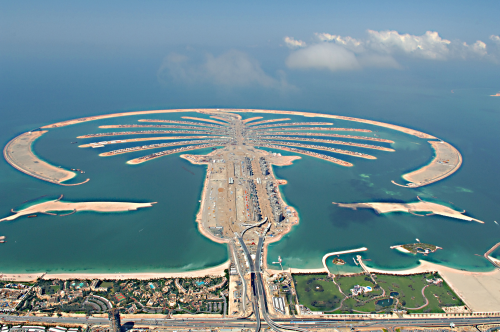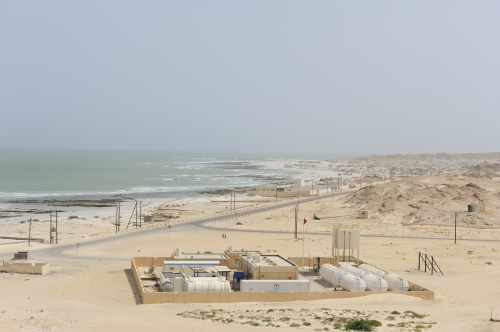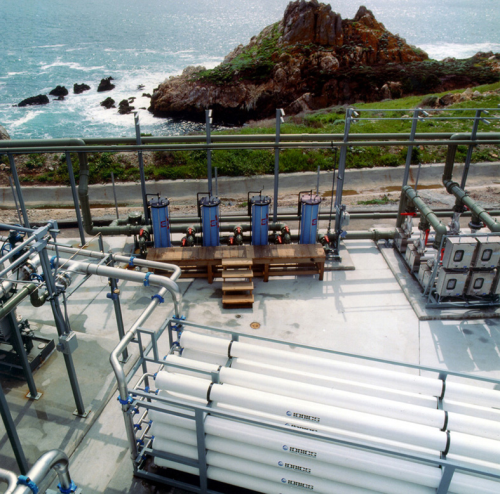



Water scarcity
We read about ‘water scarcity’ and ‘climate change’ issues in the news regularly, not only in technical publications like this but in daily newspapers and popular magazines. We asked Erik Hanson, the desalination global product manager at GE Power & Water, for his views on these global problems. He said: “What used to be only a topic for ‘water industry insiders’ has now become common in political, economic, and even casual conversations. He added: “Of course, the bad news is that water scarcity is deserving of all this attention. It is a significant and well documented problem that continues to grow worse as population and industrialisation grow and expand. The good news is that all this attention has led to many advances - both in technology and in manufacturing practices - to improve the situation.” Climate change and shifting population demographics, which exacerbate water shortages in certain areas of accelerated population growth, are adding to population growth and industrialisation to create areas where reliable fresh water supplies are being severely stretched. Seawater provides an obvious resource to tackle the resulting problem of water scarcity, especially in coastal areas (see Figure 1). Compounding water scarcity is the global energy consumption issue, as described by Tom Rooney, chief executive officer at Energy Recovery Inc, as “the water/energy nexus.” Rooney explains that water and energy are intimately linked, as the production of water requires a significant amount of energy, and the production of energy requires a significant amount of water. “To truly address the global water crisis,” Rooney suggests, “solutions must also take into account the need for energy conservation.” Hanson told us that we see an enormous amount of focus today in the water industry on solving water scarcity in two different, but related directions. “Advances in water reuse,” he said, “allow people to make better use of water that has already served one need, but with the right treatment could go on to serve one or more additional purposes. Advances in desalination make it more economical to turn seawater into potable water or with further treatment into water for industrial purposes.”
Trends in desalination technology
As reported by Graeme Pearce, of Membrane Consultancy Associates, since the late 1990s, desalination markets have grown strongly, with seawater reverse osmosis (SWRO) spirally-wound membranes becoming established as the main technology employed today for large-scale industrial and municipal applications [1]. Compound growth between 1997 and 2008 was 17%, exceeding the expectations of the RO industry. These high growth rates are continuing to accelerate. Hanson told us that, according to Global Water Intelligence, desalinated water operating costs have fallen over the last 20 years from an average of US$1.25-1.50 per m3 treated water in the early to mid-1990s to less than US$0.75 per m3 treated today. This ongoing reduction in cost is driven both by technical improvements to processes that lower operating costs and by improvements in manufacturing practices. The latter have significantly lowered the initial capital investment required to build a desalination plant. Desalination of seawater by unit processes has been possible for well over 100 years. Initially, thermal technologies were exclusively developed by companies such as Caird & Rayner Clark to remove salt from seawater by boiling the water and capturing the condensate. These technologies are very effective at removing salt from water, and they remain an important part of global desalination today especially where waste steam or other forms of heat can be utilised. These are typically available in small specialist naval, marine and offshore applications and include vapour (mechanical) compression and flash evaporation technologies. The cost of the specialist and highly corrosion-resistant metals required in these thermal technologies combined with the high operating cost of generating enough heat on larger applications led researchers to develop alternative desalination methods. Membrane-based technologies were developed in the late 1960s and over recent years these have emerged as the common technology in large scale desalination. The main technology used is SWRO, a cross-flow membrane separation process providing a level of filtration down to ionic levels for removal of dissolved salts. Permeate is produced from the membrane with the majority of the dissolved content of the feed transferred to the waste concentrate stream. Depending on the quality of the feed water supply, SWRO membranes can be configured in a desalination system to give an overall concentrate stream flow typically 40% of the feed supply, equating to an overall system recovery of up to 60%. The salts present in the feed supply are concentrated and passed to the rejected concentrate stream. There is another emerging approach to water resource development with the potential for lower energy use. It is based on the principle of osmosis and has been described by Pearce [2]. Although these direct osmosis processes have also been around since the 1960s, commercialisation is relatively recent. In SWRO, the established way of exploiting osmosis is to operate the process in reverse by applying pressure to the saltwater side of the membrane to initially overcome the osmotic pressure and then to drive water from the saline to the freshwater side of the membrane. As osmosis is a process in which water is transported through a semi-permeable membrane due to a difference in chemical potential between two solutions, water will naturally diffuse through the membrane from the freshwater side to dilute the higher salinity solution. This generates a head of pressure which is dependent on the salinity difference of the two solutions. Compared to SWRO, direct osmosis might not seem to be useful as the process provides a smaller quantity of freshwater and a larger quantity of a less saline saltwater. However, direct osmosis processes offer a novel approach through the potential for harnessing energy through different system designs by exploiting the osmotic principle. Systems which are designed to produce water are called Forward Osmosis (FO) systems, and it is this technology that lies at the heart of Modern Water’s Manipulated Osmosis Desalination (MOD) technology (see below). Energy recovery schemes are normally termed Pressure Retarded Osmosis (PRO). A number of variants and combinations of these process schemes are being developed, together with the combination of FO and PRO with other membrane technologies. Depending on the feed water available, additional membrane technologies may be incorporated as pre-treatment technologies. Ultrafiltration (UF) technology can be effectively used as a pre-treatment for SWRO depending on the nature and variability of the feed supply to the water treatment system. Pearce told us that annual growth rates for UF and microfiltration products in water treatment have also been exceptionally strong in the last few years at around 20%. Various factors have come together over recent years to reduce the OPEX (operational expenditure) and CAPEX (capital expenditure) of desalination systems. Hanson told us that desalinated water operating costs have fallen over the last 20 years from an average of US$1.25-1.50 per m3 in the early to mid-1990s to less than US$0.75 per m3 today. He said: “This ongoing improvement in cost is driven both by improvements to technology that lower operating costs and by improvements in manufacturing practices that have significantly lowered the initial capital investment required to build a desalination plant.” Technologies that contribute to these lower costs include advances in pre-treatment, higher efficiency pumps, membranes and energy recovery devices.
Lowering OPEX
We will now consider various operational factors that are improving the cost-effectiveness of SWRO desalination.
Improvements to RO membranes
Manufacturers are including more membrane area per membrane element and operating pressures are being steadily reduced. Both factors are continuing to reduce membrane replacement costs and associated energy requirements.
Introduction of emerging technologies
As already summarised, forward osmosis (FO) is now being increasingly used in membrane desalination. A draw solution is used in the FO process to create a driving force for freshwater to pass through the membrane. This draw solution is more concentrated than the seawater and is a solution of an osmotic agent, typically ammonium bicarbonate. The FO membrane is supplied with saline water and the permeate passes through into the draw solution by osmosis due to the difference in concentration. The solutes in the draw solution are then recovered and reused and the purified draw solution forms the treated water. Modern Water’s patented MOD technology is described as a two-stage process that combines forward osmosis (FO) with reverse osmosis (RO). Two different systems have been operating in the Sultanate of Oman for over 18 months [3]. One of these projects is at Al Khaluf, 400 km south of Muscat. At the Khaluf site, Modern Water’s 100 m3 per day containerised unit (see Figure 2) operates alongside a conventional SWRO system owned by the Public Authority for Electricity and Water. The FO part of the process operates at 35 percent recovery to dilute the draw solution before it is desalinated by high-pressure SWRO membranes to produce potable water with 120 mg/l TDS (total dissolved solids). During desalination, the proprietary osmotic agent in the FO draw solution is concentrated and reused. The diluted feed is reported to reduce desalination energy requirements by more than 20 percent. Also, the chlorine-tolerant and fouling resistant FO membranes produce a virtually particulate-free feed to the RO process.
Utilisation of UF technology
For effective and reliable pre-treatment, UF membrane technology solutions have been developed by various companies including Pentair X-Flow. They offer two dedicated solutions for SWRO pre-treatment systems: Seaguard (horizontal configuration) and Seaflex (vertical configuration), both including hollow fibre UF membranes that provide a highly effective single barrier to reduce SWRO membrane fouling. Seaguard UF pre-treatment membranes have been supplied on two SWRO desalination plants in Dubai, which were designed to supply water to hotels and commercial developments on the ‘Crescent of the Palm’ at Jumeirah (see Figure 3). Colin Reith, UK sales manager at Pentair X-Flow, told us that SWRO pre-treatment is becoming more critical. Improvements to RO membrane elements and other factors are leading to a higher tendency for SWRO fouling resulting from: • lower cross flow velocity in the SWRO tail elements; • higher convective velocity towards the SWRO membrane surface; • longer residence time in the RO system. Reith said: “Over the last five years UF is gaining more and more significance as pre-treatment, compared to conventional pre-treatment. Up until now UF was deemed to be more expensive in both investment costs as well as operating costs.” Conventional pre-treatment includes coagulation, sedimentation, media filtration and cartridge filtration technologies. Pentair X-Flow has calculated that a significant saving in OPEX on a typical large scale 150,000 m3/day SWRO desalination plant would be achieved over a full life cycle (25 years) by using UF technology instead of these conventional technologies. Reith added: “UF technology offers clear and significant benefits in operating costs, when compared to conventional pretreatment for RO desalination plants. Especially the long term benefits of a reduction in RO cleaning frequency, longer RO membrane life time and lower SWRO energy consumption are significant. These benefits cannot be assessed during pilot testing but become obvious with many more plants being successfully operated for several years.” He also commented on FO and said that a critical aspect of the operation of FO systems is the contamination by suspended solids, microbiology and colloids. He explained: “This makes pre-treatment with UF membranes an ideal solution in order to improve the overall system performance and output as has already been proven at a large amount of RO installations.”
Optimisation of chemical dosing
Coagulation can be used up front of UF systems with the potential to improve SWRO feed quality further. Research is currently ongoing and the role of coagulants in membrane pre-treatment of seawater will be summarised by Pearce later this year at the International Desalination Association world congress in Perth, Australia. Pearce will review field experience from case studies on different continents utilising different membrane suppliers. Pearce said: “Although it was initially hoped that membrane pre-treatment could completely avoid the use of chemicals, it can be seen from field experience that some use of coagulant is beneficial both to the membrane filtration stage and to the RO. The best option is to utilise a low coagulant dose during periods of poor feed quality (normally about 30% of the time), typically at a third or less of the concentration required by conventional pre-treatment. This concentration can then be reduced, potentially to zero, when feed quality is good.”
Advances in pump design
Significant advances have been made to positive displacement (PD) pumps. Hanson said: “These are extremely energy efficient, typically resulting in efficiencies above 90%. These pumps are unfortunately only installed in smaller applications today due to capacity limitations of the technology. “Centrifugal pumping technology, which is the primary pumping method for larger capacities, has also seen improvements in efficiency. Today’s largest desalination plants utilise very large centrifugal pumps, and although they are not as efficient as PD pumps, they are very efficient for centrifugal pumps simply due to their scale.” Eric Kadaj, senior technical manager at Energy Recovery Inc, agrees that the use of centrifugal pumps has increased in recent years as they are simpler to operate and maintain, and easily scalable to larger capacities. Kadaj notes that centrifugal pump efficiencies have also improved due to innovations such as development of Computational Fluid Dynamics (CFD) software as well as improvements in manufacturing processes. “Essentially what CFD software does,” Kadaj explained,” is optimise hydraulic design, allowing pump manufacturers to precisely model the entire hydraulic capacity of the pump and reduce efficiency losses internally.”
Increasing waste energy recovery
In the early days of desalination, the PD and centrifugal pumps provided 100% of the energy to power a SWRO plant, but innovations in the field of energy recovery have improved energy efficiency. Hanson added: “Waste energy from reverse osmosis can be recovered, and can account for 25-30% of the energy required to overcome the osmotic pressure of seawater. This lowers the total energy requirement of desalination plants dramatically. “Nearly all membrane based desalination plants today utilise some form of energy recovery. Future innovations in pumping and energy recovery, combined with innovations in membrane technology, hold the key to lowering the operating cost of desalination even further.” Various companies provide solutions for recovering waste energy including Energy Recovery Inc, whose isobaric PX™ Pressure Exchanger technology can reduce the energy consumption in SWRO and brackish RO systems by up to 60%. You can read more about ERI’s technology elsewhere in this issue of Filtration + Separation.
Lowering CAPEX
An equally important aspect of lowering the costs of desalination is the reduction made in the CAPEX of membrane-based SWRO systems. Hanson explained: “This cost bears a direct relationship to the overall cost of water, as most plants are financed and their initial costs are amortised and rolled into the overall cost of water produced.” Hanson explained that recent average water tariffs have shown that CAPEX and financing costs of a typical SWRO desalination plant can account for as much as a third of the total water tariff (US$ 0.25-0.30 per m3 treated water out of a total of US$ 0.75 per m3 on a typical large plant). Companies such as GE Power & Water have made significant progress in lowering the cost of packaged membrane-based desalination plants. Pre-engineered plants, such as the SeaPRO-E product line, typically serve capacities of 500–10,000 m3 per day, and can be built in an assembly-line style (see Figure 4). Good manufacturing practices combined with pre-engineered designs help make assembly of these large systems more repeatable and, therefore, more cost-effective. They drive efficiencies in assembly labour as well as efficiencies in purchasing. Building products based on common components across a product line results in better sub-assembly pricing. All of these productivity gains are felt by customers in the desalination marketplace, as the CAPEX cost of desalination continues to be driven downwards.
Conclusion
Future advances in technology and in manufacturing practices will continue to drive the downward trend in the cost of desalination. Advances in pre-treatment combined with advances in membrane technology will result in lower cost systems in the future that will be even more reliable than they are today. Combining advances in pre-treatment, FO and SWRO membranes with future advances in pumping and energy recovery gives us a glimpse into the future of low cost yet highly reliable desalination plants. The world will continue to face pressure on its water supply. Population growth, climate change and industrial development with increased energy requirements will inevitably force that trend to continue. But the high visibility of the water scarcity issue today has driven and will continue to drive innovation and investment in the water sector, with the development of emerging technologies and improved manufacturing processes.
References
[1] Pre-treatment to Seawater Reverse Osmosis: Markets and Experience, G Pearce, Filtration and Separation, November/December 2009, p30. [2] Direct Osmosis: Revisiting the Problem of Water and Energy, G Pearce, Water & Wastewater International, December 2010, p22. [3] Company News - FO Plant Completes one year of operation, Water Desalination Report, November 2010, p2.






